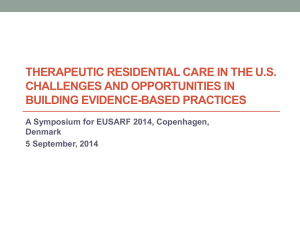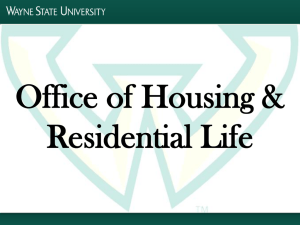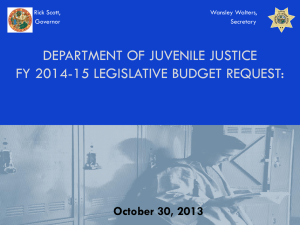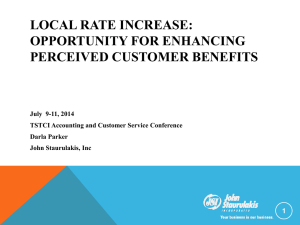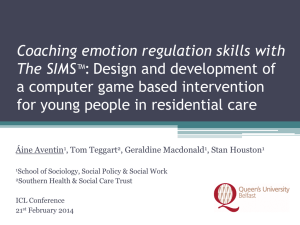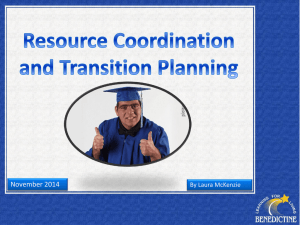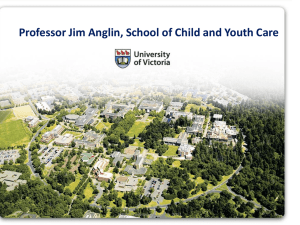The touchstone of good residential/ group home care
advertisement
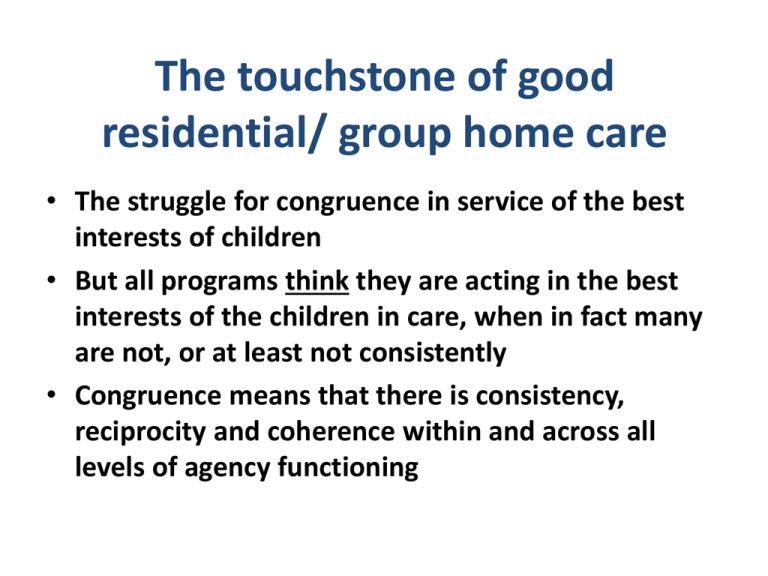
The touchstone of good residential/ group home care • The struggle for congruence in service of the best interests of children • But all programs think they are acting in the best interests of the children in care, when in fact many are not, or at least not consistently • Congruence means that there is consistency, reciprocity and coherence within and across all levels of agency functioning Levels of Group Home Operation • • • • • Extra-agency Management/Leadership Supervision and Clinical Carework/Teamwork Child and Family Basic psycho-social processes • Creating an extra-familial living environment – the prime task of managers • Responding to pain and pain-based behaviour – the key challenge for careworkers • Developing a sense of normality – the basic need for young people in care All positive changes can be traced to 11 interactional dynamics • • • • • listening and responding with respect; communicating a framework for understanding; building rapport and relationship; establishing structure, routine and expectations; inspiring commitment; Interactional Dynamics (cont’d) • • • • • • offering emotional and developmental support; challenging thinking and action; sharing power and decision-making; respecting personal space and time; discovering and uncovering potential; and providing resources. The Framework Matrix for Understanding Group Home Life and Work k) Providing resources j) Discovering & uncovering potential i) Respecting personal space & time h) Sharing power & decision-making Interactional g) Challenging thinking & action Dynamics f) Offering emotional & developmental support e) Inspiring commitment d) Establishing structure, routine & expectations c) Building rapport & relationship b) Communicating a framework for understanding a) Listening & responding with respect Levels of Group Home Operation Extra-agency 5 Management 4 Supervision 3 Carework 2 & Teamwork Youth and Family RECIPROCITY 1 I Creating an extrafamilial living environment II III Responding Developing a to pain and sense of pain-based normality behaviour Basic Psychosocial Processes CONSISTENCY COHERENCE Core Theme: CONGRUENCE IN SERVICE OF THE CHILDREN’S BEST INTERESTS Moving from “last resort” to positive option in the system of care • Placing workers need to accept that well-functioning group care is positive for the right young people, at the right time • There needs to be a move away from a mechanical formula for placement that leads to multiple foster home “breakdowns” before a residential placement • Child welfare systems need to invest in developing and maintaining well-functioning group care • Workers need to carefully assess the level of care, supervision and intensity required by youth The challenge of decision rules For example: • All children have a right to live in a family (except those who can’t) • Try (all) less intrusive services before more intrusive alternatives (but less intrusive for whom?) • Place a child in residential care only as a last resort (which may mean years of misplacements and pain) • Every child has a right to permanency and stability (but what do we do to ready them for such a place?) • Others? We are at an exciting time in the evolution of our understanding of why some young people struggle with the challenges of everyday life… and the role quality residential care for young people can play in helping these young people to turn around and learn to self-regulate. Therapeutic residential care is the term being used internationally for trauma-informed and therapeutic relationship-based approaches A recent development is the convergence of the emerging field of neuro-biology and child and youth care Especially the work of Bruce Perry (MD, PhD) Brain research is now demonstrating that: • Early childhood traumas alter the development of neural pathways in the brain; • but thanks to neuroplasticity, consistent, nurturing caregiving over the course of everyday life can help to create new pathways; • through creating a sense of safety, human connections and “scaffolding” for self-regulation. Dr. Perry’s research has demonstrated the importance of therapeutic relationships in healing the effects of childhood trauma “We learned that some of the most therapeutic experiences do not take place in “therapy”, but in naturally occurring healthy relationships… “ (p.70) “People, not programs, change people.” (p. 80) [From: The Boy Who was Raised as a Dog, by Bruce Perry and Maia Szalavitz, (2006) New York: Basic Books] There is growing international evidence that implementing strong therapeutic residential care models is having a positive impact on the quality of care provided and the child outcomes being achieved. Strong models target the whole residential agency (and preferably the child protection system) to implement a principle-based approach that truly serves the best interests of children. An effective system needs to be congruent within and across all levels So, what is the evidence for its effectiveness? • The criteria for “evidence-based practice” are based on the medical drug-trial model, and require “randomized control trials” (RCTs) which are expensive, challenging and raise ethical issues to do in residential care. • However, recent non-RCT evaluations of therapeutic models in the State of Victoria (Australia), Northern Ireland and the USA (Cornell University) have shown positive and promising results, and findings from even more rigorous studies will be available in the near future. From TRC Evaluation (Verso Consulting, State of Victoria, Australia, 2011) Significant improvements in placement stability Children and young people placed in a TRC have experienced far greater stability compared to their previous experience. Significant Improvements to the quality of relationships and contact with family The children and young people in TRC have experienced and sustained significant improvements to the quality of contact with their family during their period in TRC. Sustained and significant improvements to the quality of contact with their residential carers over time in the TRC pilots Children and young people in the TRC pilots are developing and sustaining secure nurturing, attachment-promoting relationships with residential carers in the TRC Pilots. Increased community connection Children and young people in the TRC Pilots were more likely to engage in community activities or have a part time job than young people in general residential care. Significant improvements in sense of Self Children and young people in the TRC have experienced and sustained significant improvements in their sense of self, indicating improved mental health. Increased healthy lifestyles and reduced risk taking Children and young people in the TRC experienced a reduction in risk taking which was evident over time in reduced episodes of negative police involvement (although not immediate), police charges and secure welfare admissions. Enhanced mental and emotional health Across the SDQ and HoNOSCA measures, the children and young people in the TRC experienced improvements and significant reductions in the mental health symptom severity. The development and implementation of therapeutic residential care is a movement towards congruence across an entire agency and, ideally, the whole child welfare/protection system. To be effective, every person in an agency/system needs to be: • knowledgeable about therapeutic principles, values and practice methods; • working consistently in alignment with therapeutic principles and values, and • supported in an ongoing way (‘scaffolding’) to put them into practice. • It takes an agency about 3 years to make the initial transition, but the residents notice and respond to the change right away Residential care is not rocket science, It’s far more complex than that! References Anglin, J.P. (2002). Pain, Normality and the Struggle for Congruence: Reinterpreting Residential Care for Children and Youth. Binghamton, NY: Haworth Anglin, J.P. (2012). The process of implementing the CARE program model. Paper presented at EUSARF/CELCIS Looking After Children Conference, September 6, Glasgow, Scotland. Holden, M.J. (2009). Children and residential experiences: Creating conditions for change. Arlington, VA: Child Welfare League of America. Holden, M.J., Anglin, J.P., Nunno, M.A. & Izzo, C.V. (2014) Engaging the total therapeutic residential care program in a process of quality improvement: Learning from the CARE model. In Whittaker, J.K, del Valle, J. F. & Holmes, L. (Eds.) (2014) Therapeutic Residential care for Children and Youth: Developing Evidence-Based International Practice. London: Jessica Kingsley Press. Kahn, W.A. (2005). Holding fast: The struggle to create resilient caregiving organizations. New York: Brunner-Routledge. Lee, B.R. & Barth, R.P. (2011). Defining group care programs: An index of reporting standards .Child and Youth Care Forum, 40 (4), 253-266. Li, J. & Julian, M.M. (2012). Developmental relationships as the active ingredient: A unifying working hypothesis. American Journal of Orthopsychiatry, 82 (2) 157-166.


